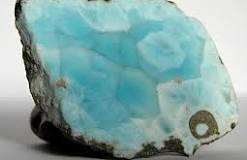
Larimar: The Ocean Stone of Serenity and Strength
Exploring the Meaning, Origin, and Jewellery Potential of this Rare Caribbean Treasure
Geological Profile of Larimar
Larimar, also known as the “Dolphin Stone” or “Atlantis Stone,” is a rare variety of blue pectolite found exclusively in the Dominican Republic. Its striking hue ranges from soft sky blue to deep volcanic aqua, often patterned with white marbling that resembles sunlight dancing through shallow tropical waters.
Chemically, Larimar is a sodium calcium silicate hydrate (NaCa₂Si₃O₈(OH)), part of the larger pectolite family. However, unlike most pectolites—which are typically white or grey—Larimar gains its characteristic blue from copper inclusions, making it truly unique among gemstones.
-
Hardness: 4.5 – 5 on the Mohs scale
-
Lustre: Vitreous to silky
-
Transparency: Translucent to opaque
-
Crystal System: Triclinic
The only known deposit of Larimar lies in the Bahoruco Mountain Range of Barahona Province, discovered in 1974 by local Dominican Miguel Méndez and Peace Corps volunteer Norman Rilling. Its name is derived from a fusion of Méndez’s daughter’s name, Larissa, and mar, the Spanish word for sea.
The Energy and Healing Properties of Larimar
Larimar is widely cherished in the metaphysical realm as a stone of divine feminine energy, calming waters, and gentle communication. Its soothing vibration resonates strongly with the throat chakra, encouraging clear expression, compassionate truth, and emotional release.
Energetically, Larimar is said to:
-
Calm stress and anxiety, especially related to emotional wounds or unspoken truths
-
Support spiritual evolution and connection to the divine feminine archetype
-
Facilitate honest communication in relationships, with oneself and others
-
Enhance meditation and heart-centred awareness
-
Help process grief, fear, or inner turbulence with oceanic grace
Larimar is often recommended for those feeling overwhelmed, emotionally drained, or energetically blocked. Its association with the element of water makes it especially potent for balancing excessive fire energy—be it anger, burnout, or impulsivity.
The Natural Allure: Larimar in its Raw State
One of the most captivating aspects of Larimar lies in its natural formation. Raw or minimally cut specimens display undulating blue tones that shift with the light—like waves rippling across a coastal tide pool. These unique patterns are not artificially enhanced, making each stone inherently one-of-a-kind.
When used in mineral specimen jewellery, the appeal of Larimar is elevated:
-
Its organic shapes and surface textures bring tactile authenticity to adornment
-
Rough-edged settings or open-backed designs preserve its raw spirit
-
The stone’s satin finish contrasts beautifully with minimalist metals like silver or oxidised bronze
Such natural beauty makes Larimar not just a crystal, but a wearable piece of oceanic earth energy.
Historical and Mystical Associations
While Larimar lacks the long-recorded mythologies of ancient stones, it has quickly gained mystical recognition since its rediscovery in the 1970s. Some believe it to be the "lost stone of Atlantis", connecting it to the legend of an advanced spiritual civilisation submerged beneath the sea. This association is primarily driven by Edgar Cayce's prophecy of a blue healing stone that would surface from the Caribbean.
Among Caribbean cultures, Larimar is increasingly regarded as a national treasure and a stone of oceanic harmony. Artisans and healers alike view it as a conduit to higher spiritual guidance, particularly aligned with dolphin and whale energy—symbols of deep emotional intelligence and unity consciousness.
Comparison with Other Blue Crystals
Larimar is frequently compared with other calming blue gemstones such as:
-
Aquamarine: Though also linked with the sea, aquamarine tends to be clearer and harder, with a more crystalline appearance. Larimar is softer, often more tactile, and has a silky, fibrous matrix beneath the polish.
-
Blue Lace Agate: Shares the soothing communication energy, but lacks the unique Caribbean provenance and layered oceanic colouration.
-
Turquoise: A grounding, protective stone with historical cultural use, but Larimar's spiritual focus is lighter, more ethereal, and deeply nurturing.
In short, Larimar stands apart as a stone that unites fluid intuition with calm, expressive clarity, all encased in a colour palette that feels like the sea made solid.
Larimar in Jewellery: A Touch of Earth and Water
Because of its softness, Larimar is often cabochon-cut—but in the hands of mineral specimen jewellers, it is also set raw, embracing its naturally flowing shapes and textures.
Designs that highlight Larimar’s matrix inclusions, natural undulations, and polished vs. unpolished contrasts are highly sought-after in contemporary raw crystal jewellery. Rings, pendants, and earrings featuring raw Larimar offer:
-
A visceral connection to the ocean and Earth’s watery rhythms
-
A cooling, feminine counterbalance in warmer-toned jewellery collections
-
Distinct visual identity for those seeking spiritual meaning in artisanal adornment
Jewellery made with natural Larimar specimens bridges art and alchemy—transforming a rare geological gift into something intimate and wearable.
A Note on Craftsmanship
Select designers who work with Larimar as a raw mineral prioritise preservation of energy, ethical sourcing, and respect for the stone’s organic beauty. Brands like ours, based in the UK, craft mineral specimen jewellery that honours these values. Each Larimar piece becomes not just an accessory, but a companion on your emotional and spiritual journey.